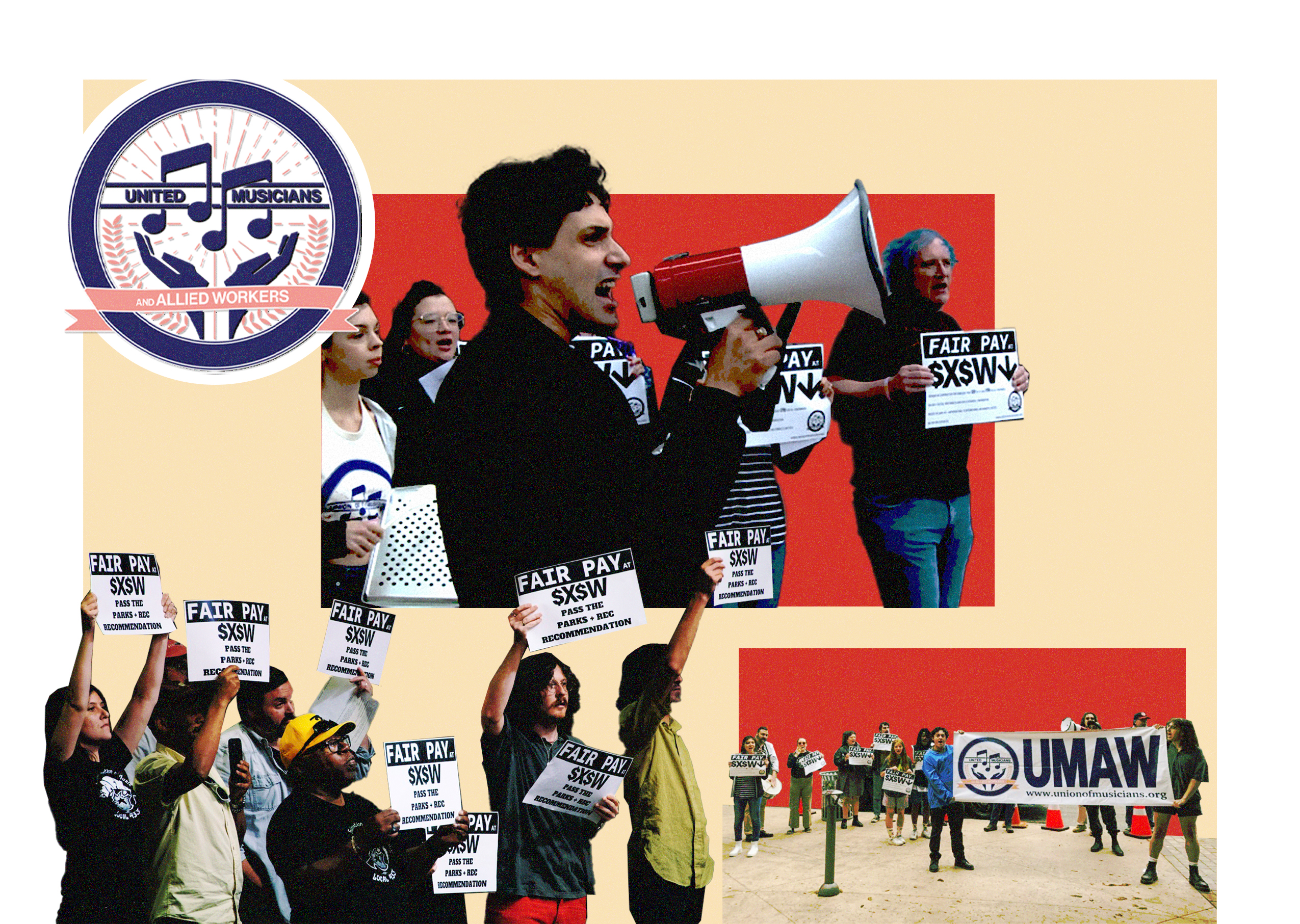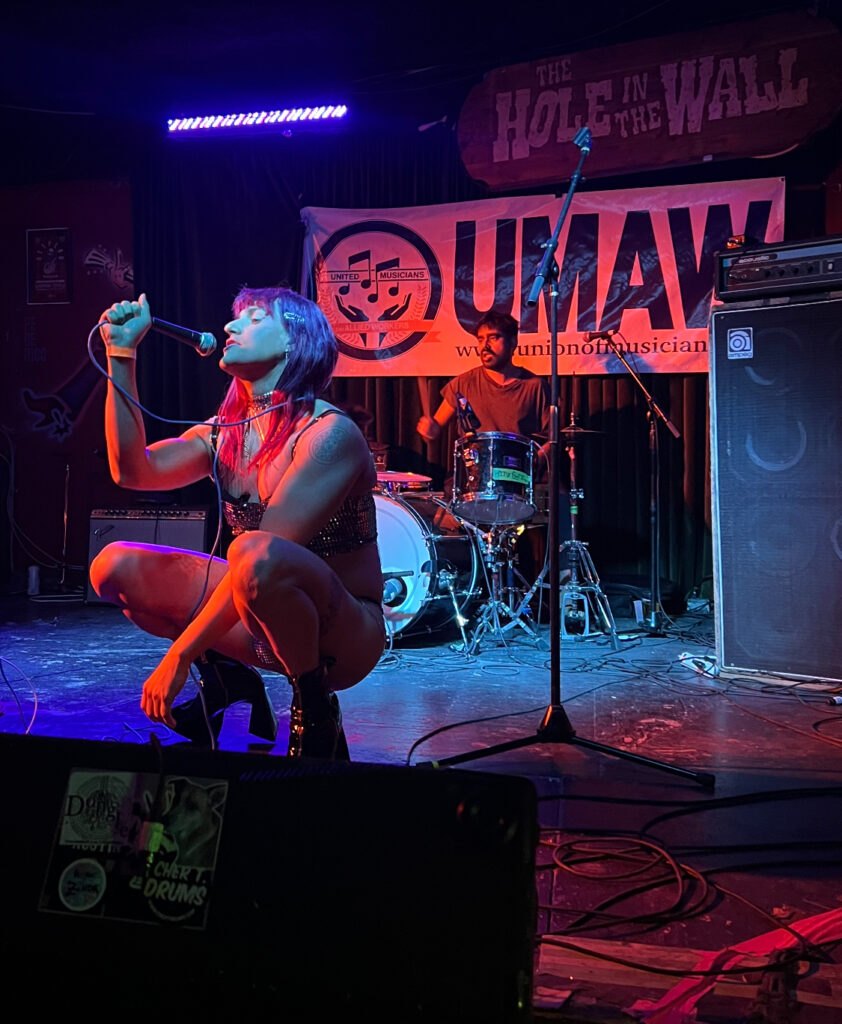
An upstart performer group is joining the fight to get the famous Austin festival to pay its fair share.
Like 1,500 other performers and bands, Joey La Neve DeFrancesco will travel to Austin, Texas, this week for a showcase at South by Southwest. The music performances at the city’s famous festival, commonly abbreviated as SXSW, last year drew more than 150,000 attendees, giving new artists a shot at the national spotlight. DeFrancesco and other members of United Musicians and Allied Workers (UMAW), a young organization looking to improve working conditions for musicians, are aiming the spotlight elsewhere: at what they say is abysmal pay for the festival’s performers.
The 4-year-old organization’s flagship event at SXSW is the Fair Pay at SXSW showcase, scheduled for March 13. Now in its second year, the show is one of a growing number of public events aimed at publicly protesting the festival’s pay.
***
Independent musicians — artists who work outside of the major record labels in varying capacities, releasing music via independent labels or on their own — are famously paid little, and SXSW’s rates are no exception. Lauding the “indispensable networking, mentoring, and career development opportunities” at SXSW, the festival primarily compensates bands by offering them free badges to the festival of which they are a part.
Artists can choose cash instead, but until this year, SXSW offered solo artists $100 and multi-member bands $250 — the same rate it had been paying for more than a decade. The festival raised rates this year after a combination of community pressure and artist unrest — including UMAW’s inaugural showcase last year and a petition signed by almost 2,500 artists. (Notable signatories include Songwriters of North America, and the bands Wednesday and DIIV.) The new rates, however, remain modest: $150 per solo artist, and $350 per band.
Many observers have noted that the festival could likely afford to pay more. In 2022, Penske Media Corporation, a privately held company that’s home to more than 20 flagship publications, from Variety to Artforum, became a 50% owner of the festival. Started in 1987 by members of local alt-weekly The Austin Chronicle, SXSW now charges $945 per person for a pass to the music shows and conference. A comprehensive “platinum experience,” which grants entry to talks, interactive events, and film screenings, meanwhile, costs $1,990. Festival reps say that 90% of last year’s artists opted for music badges instead of cash.
SXSW and Penske Media did not respond to requests for comment.
When Memphis musician Josh Shaw’s band Blvck Hippie first played the festival in 2022, they opted for the festival music badges instead of splitting the band fee — which would have translated to $41 each. On the first night, three people slept in their van, and the other three slept in the lobby of a hostel. Shaw says the band spent half of their trip seeking out free food at events. They showered when a friend let them all crash at their place the second night. Even under those conditions, says Shaw, independent musicians feel like they have little choice but to play the festival if invited. There’s still the distinct possibility of finding new audiences and the chance to connect with other performers.
“Everybody has this understanding [that] it sucks,” says Shaw. “Even if you don’t really believe in it, you have to kind of pay the piper.”
While SXSW provides a flashpoint, UMAW is hoping to address the low income of musicians more broadly, targeting popular issues like poor compensation from streaming services and merchandise practices at shows. The group began in April 2020 during early-pandemic email conversations and video chats among independent musicians on how they might change their working conditions. UMAW’s first official action, a May 2020 letter demanding government relief for musicians who were out of work, was supported by more than 700 artists, including punk legend Alice Bag and members of Fugazi and Sonic Youth.
Indeed, says Liz Pelly, a New York-based journalist who covers Spotify, the rise of pro-rata streaming services that pay artists only when a song gets a unique “stream” has made record sales nearly irrelevant to artists’ income. “It puts independent musicians in competition with top stars in a new way, in an ecosystem designed to monitor and reward types of music that generate the most streams,” she says.
The pandemic’s shutdown of touring confronted musicians with just how little they were making outside of live shows, says DeFrancesco. “Musicians were super-desperate,” he says. “All of our work had dried up. It was going from making shitty money before the pandemic to making zero money, and simultaneously watching Spotify triple in market value while we were making nothing. We all were out of work and had some time to put something together.”

Independent artists can join unions like the American Federation of Musicians, which represents about 70,000 musicians in the U.S. and Canada. But while American Federation of Musicians contracts can easily govern pay for musicians with single employers — symphonic orchestra members, for example, or musicians working in theater — touring musicians typically work a different gig with a different employer each night. That work is typically classified as an independent contract under the National Labor Relations Act, which makes demanding broad protections difficult.
DeFrancesco, who performs as La Neve and with the five-person band Downtown Boys, says he knows virtually no one earning their living from music alone. DeFrancesco estimates that in his band’s best year, they pulled in roughly $50,000 — just $10,000 per member. Now age 35, he pads his music income with work as an organizer with the nonprofit Demand Progress.

Leaders with the American Federation of Musicians, a musician’s union, have also criticized the festival. Local musicians and community organizers have advocated for better pay at the festival for years, says Aaron Lack, president of Austin Federation of Musicians. “They want to unilaterally dictate terms rather than negotiate with musicians,” says Lack; efforts to get a union contract for performers have failed so far. Last year, the local union passed out leaflets explaining the pay issue to festivalgoers. “We were working with [UMAW] in tandem,” says Lack, “and I think that that certainly scared [SXSW].”
UMAW’s ad hoc, confrontational organizing culture feels like a more natural fit for some artists. “It’s hard to believe that [the American Federation of Musicians] are still in it for the good of everyone, not just the good of a few people on the board,” says Shaw. UMAW, he says, feels more committed to helping workers, whether they have bargaining rights under labor law or not. “[They’re] more real,” he says.
Even without a cultural disconnect, “there are lots of good reasons why workers might be motivated to start their own organizations,” says Greig de Peuter, a professor at Wilfrid Laurier University in Waterloo, Ontario, Canada, who studies cultural workers. Indeed, says de Peuter, “alt-labor” groups like UMAW have emerged in cultural industries where independent contracting is the norm: art galleries, video game companies, and online media. “[These] workers may not have the right to engage in collective bargaining, and they have to struggle for those rights to be granted to them,” says de Peuter.
In any event, says AFM’s Lack, musicians have to work together. “Musicians don’t have to choose between an advocacy group and their union,” says Lack. “The idea that this is a binary choice only serves the employers that exploit us.”
When SXSW gets underway, there’s a possibility that some aspects of the performer experience might be different. For its 2024 edition, SXSW boasts “artist-only benefits” for showcased performers, including artist-only hotel blocks, complimentary meals and drinks, “artist gifting” and “exclusive artist services.” Lack’s understanding is that some of the benefits were added after American Federation of Musicians members spoke last year about the inadequate facilities in artist-only hospitality locations around downtown, but he hasn’t yet heard if the issues have been addressed.
Things at the March 13 Fair Pay at SXSW showcase, however, will stay much the same. UMAW will reprise much of the format from last year. This year, it’ll take place at Cheer Up Charlies, a downtown gay bar with a patio shaded by a parachute. Like last year, UMAW plans to turn the mic over to supporters ranging from public officials to striking workers to speak between performers. And like last year, UMAW will pay performers the same rate they think SXSW should start using as a minimum: $750 per act. The number, says DeFrancesco, seemed like a reasonable increase.
“Our scrappy, no-budget organization is able to pay artists fairly,” says DeFrancesco, who adds that around 80% of the show’s budget came from donations at the door. “Why can’t this billionaire corporation pay artists fairly?”
Copyright Capital & Main 2024.
Correction: The photograph of musicians holding signs in support of fair pay was taken at an Austin Music Commission Meeting, not an Austin Parks and Rec Commission Meeting, as incorrectly stated in a photo caption.
This piece has been updated to reflect AFM’s ongoing interest in collaborating with musician groups and establishing a union contract for musicians at SXSW.